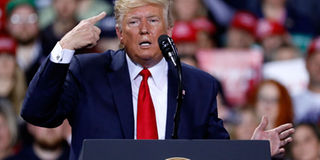Prime
Trump and Ukraine: A chronology from phone call to impeachment

US President Donald Trump speaks during a Keep America Great Rally at Kellogg Arena December 18, 2019, in Battle Creek, Michigan. AFP PHOTO
What you need to know:
- Trump is impeached for abuse of power in a historic vote in the Democratic-majority House of Representatives, setting up a Senate trial on removing him from office after three turbulent years.
- The vote of 230 to 197 makes Trump just the third president in US history to be impeached.
Here is a chronology of events leading to the impeachment of US President Donald Trump in the US House of Representatives. The matter now moves to a Senate trial to determine whether he will be removed from office, an unlikely event given that the chamber is controlled by his fellow Republicans.
July 25: Trump-Zelensky call
Trump holds a 30-minute telephone conversation with Ukraine's new president Volodymyr Zelensky, a former professional comedian who was elected in May.
Earlier in July, Trump -- without explanation -- suspended hundreds of millions of dollars in military assistance to Ukraine which had been approved by Congress.
August 12: Whistleblower complaint filed
An anonymous whistleblower in the US intelligence community files an internal complaint about the Trump-Zelensky call, describing it as a matter of "urgent concern."
September 11: Money released
The military assistance to Ukraine is released by the White House.
September 24: Impeachment investigation
Following days of reports that Trump pushed Zelensky to investigate Joe Biden, his potential Democratic rival in the 2020 presidential election, and his son Hunter, Democrats in the House of Representatives announce the opening of an impeachment inquiry for abuse of power.
September 25: Transcript released
The White House releases a rough transcript of the Trump-Zelensky call.
It confirms that the president repeatedly asked the Ukrainian leader to probe the Bidens and to "look into" the matter with Rudy Giuliani, Trump's personal lawyer, and with Attorney General Bill Barr.
September 26: Whistleblower complaint released
The House Intelligence Committee releases the whistleblower's complaint, which accuses Trump of "using the power of his office to solicit interference from a foreign country in the 2020 US election."
It also accuses White House officials of seeking to "lock down" access to the call transcript because of its politically sensitive nature.
November 13-21: Public hearings
Following witnesses' closed-door testimony in October, the House Intelligence Committee begins public hearings.
Those testifying on live television included top envoy to Ukraine William Taylor, former US ambassador to Ukraine Marie Yovanovitch and White House National Security Council member Lieutenant Colonel Alexander Vindman.
US envoy to the European Union and Trump ally Gordon Sondland tells lawmakers he followed Trump's orders in seeking a "quid pro quo" deal.
December 3: Report released
A final, 300-page report on the House investigation into Trump finds "overwhelming" evidence of misconduct in office and obstruction by the president.
December 10: Two impeachment charges
The House Judicial Committee unveils two articles of impeachment against Trump -- abuse of power and obstruction of Congress -- in a momentous step asserting that the US president abused his office and deserves to be removed.
December 18: Trump impeached
Trump is impeached for abuse of power in a historic vote in the Democratic-majority House of Representatives, setting up a Senate trial on removing him from office after three turbulent years.
The vote of 230 to 197 makes Trump just the third president in US history to be impeached.




